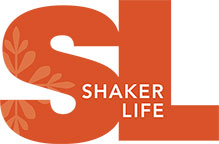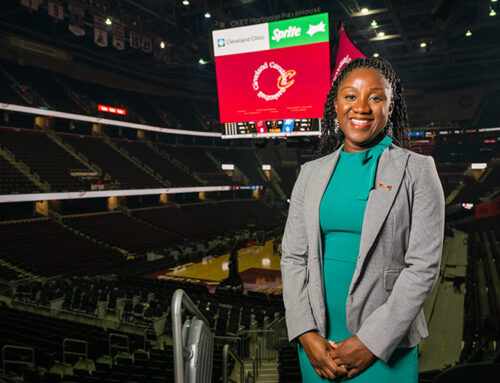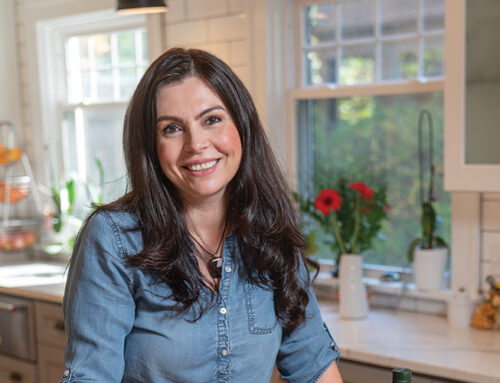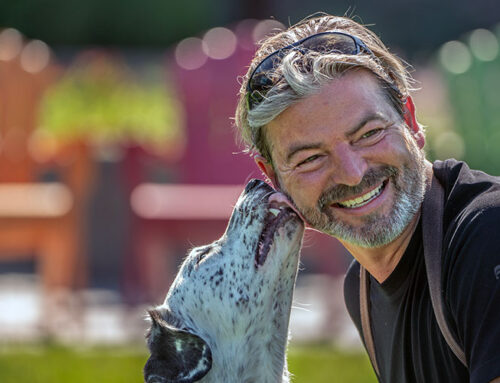Q&A with Rev. Thomas G. Fanta – aka Father Tom – Pastor of St. Dominic Church
By Jennifer Proe
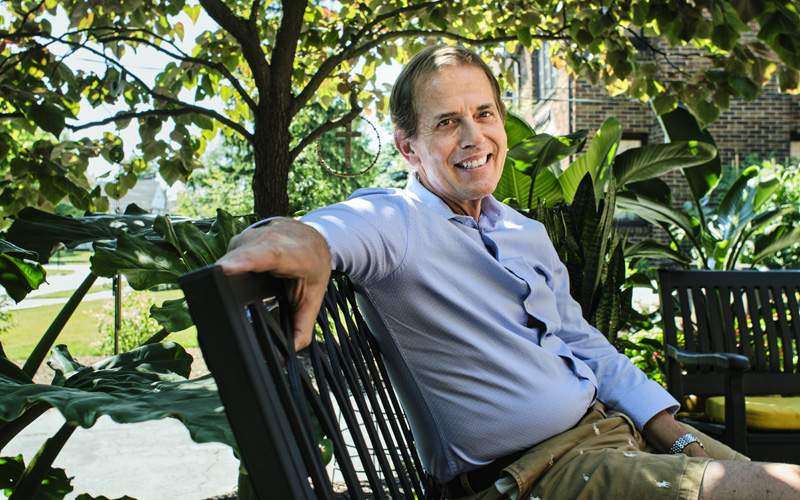
Rev. Thomas Fanta (aka Father Tom). Photography by Angelo Merendino
It’s been more years than I can count since my last Confession, but I wasn’t nervous at all about talking with the pastor of St. Dominic Church. Anyone who’s ever listened to Father Tom Fanta’s homilies knows that he’s a man of compassion and understanding, aware of his own human foibles, and has a great sense of humor. Plus, how often do you get to turn the tables on your parish priest and question him?
As the parish prepares to celebrate its 75th anniversary, and Father Tom approaches his 20th year as pastor, Shaker Life, in keeping with this issue’s theme of modernization, wanted to get his reflections on how St. Dominic has evolved over the years.
When you joined St. Dominic as Pastor, what were your initial impressions of the parish and surrounding community?
I arrived the day before my 40th birthday in 2001. I awoke my first morning with 40 black crows on the rectory front yard that said “Lordy, lordy Father Tom is 40.” I gave my first Mass here that day.
It was actually a return for me. While studying at seminary, I was assigned at St. Dominic as a seminary intern when Father Amos was the pastor in 1985. I lived and worked in the parish that year to help me to better understand the life of a parish priest.
I know you come from a large family and grew up on the West Side. When did Shaker Heights begin to feel like home?
I grew up in North Olmsted with seven siblings. I went to John Carroll University for undergrad and St. Mary Seminary for graduate school, both East Side schools. My first assignment was at St. Clare in Lyndhurst, so I have now lived longer on the East Side than the West Side. I love both sides of town, but Shaker Heights is my home. You know this is home when you get annoyed with drivers who don’t know how to navigate the Rapid tracks crossing Van Aken Boulevard.
Your initial career plan was to be an accountant. What diverted your path and led you to the priesthood?
I was always good at numbers; math was a favorite subject at St. Ignatius High School. I went to Marquette University in Milwaukee to study accounting and then transferred to JCU. When I graduated, I went to work at Kaiser Foundation Hospitals in their accounting department. I knew pretty early on I could not do that the rest of my life. As I looked out from my office at the Bond Court Building downtown, I knew I could not stay in that building. I just wanted something more than that.
How would you characterize the parishioners of St. Dominic?
The St. Dominic community is like the United Nations; we have people from all over the world. We have people from every background you can imagine, every walk of life. Many couples are of mixed marriages where the spouse often comes to worship with us even though she or he is not Catholic. It is a very welcoming place, for straight and gay couples, divorced, single and married people, older adults to young families.
What are some of the biggest changes you’ve seen over the years at St. Dominic?
When I first came here, we had 900 households and it has now grown to more than 1,700 households. I’ve seen the average age of parishioners plummet as more young families move into the neighborhood looking for a sense of community.
People come to St. Dominic looking for more than Mass – they want to do service and be involved in the community. That’s why I created the Project Serve Coordinator position [held by Jodie Bowers] for all of our outreach efforts. A shift has occurred in what it means to be a Catholic. It’s not just about going to church, it’s about how you live your faith each week.
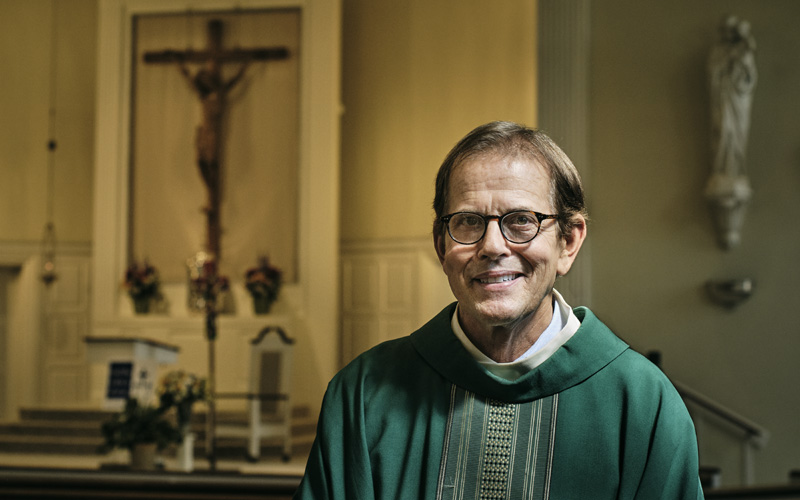
Musically, we’ve made a shift from traditional western church music to more global music to reflect the growing diversity of our parish. I hired Jim Carr, our music director, in 2002, and because of him a lot of very musically talented people have flocked here to worship with us.
Interestingly, throughout the pandemic, our collections have gone up. As churches closed throughout the country, we’ve had parishioners say to their family members and friends, “You should try watching our Mass.” We have more than 4,000 devices streaming our Mass each week.
You are now coming up on 20 years as Pastor at St. Dominic. What are some of the programs and initiatives you are most proud of developing and leading?
I think I’m most proud of our Project Serve initiatives. The community of St. Dominic truly has a servant’s heart. I am continually amazed at how every age group consistently steps forward to share their time, talent, and treasure. If I put a need in the bulletin for a car for a family, I get four. On almost a daily basis, parishioners step out of their homes and neighborhoods to serve the less fortunate, both here in our community and with our sister parish of Santo Domingo in Chultiupan, El Salvador.
We have parishioners who volunteer to prepare and serve meals at the Thea Bowman Center in the Mt. Pleasant neighborhood, at the West Side Catholic Center, at the Ronald McDonald House, at St. Herman’s shelter. They attend Mass and do crafts with developmentally disabled adults at the Warrensville Development Center. We have several immigration attorneys in the parish who volunteer their services through Hola. We’ve provided bedding for Edwins Leadership & Restaurant’s residential dorms. The list goes on and on.
How did you establish the relationship with the sister parish in El Salvador? What does that involve?
I have a friend who runs an organization called International Partners in Mission who helped me organize our first trip in 2004. I was interested in El Salvador because of Sister Dorothy Kazel, a nun from Cleveland who was martyred there. I put an announcement in our church bulletin and 14 people signed up.
The very last day we were there, we rode in a truck up to the top of a mountain and saw this church called Santo Domingo. I said, “I think that means St. Dominic. We have to stop.” There was a priest and nun there from Cleveland, and I asked if we could bring people back for another visit. They said, “Sure – but nobody ever comes back.” We’ve now had more than 1,000 parishioners go there on medical and service trips.
Over the years, we have helped them expand their school by building a library, new classrooms, and a computer lab. We’ve hired local laborers to build 200 homes and 350 outhouses for better sanitation; we’ve sent 115 of their students to college in San Salvador, supported local food delivery programs for residents with no income, and we collected $85,000 for chicken coops. That’s a lot of chickens.
You recently dealt with cancer, and thankfully you’re now in good health. What was it like to be on the receiving end of the type of pastoral care you’ve been providing to others for most of your life? To say I was overwhelmed is an understatement. The St. Dominic community is truly a family and they acted that way, supporting me every step of the way with meals, rides to chemotherapy, thousands of cards, and of course, a multitude of prayers. Many of my neighbors on Winslow Road are not members of St. Dominic, yet they were also there to give support. I also received amazing medical care. At the first meeting with my oncologist, as I was sitting there in his office, he said, “Mr. Fanta, you just look so familiar.” I said, “You sit in the back of the church on the right-hand side.”
As the only priest serving a large parish, you probably don’t have a lot of downtime. What do you do to restore the work-life balance? How do you unwind and relax?
In a typical year, we have 20 weddings, 100 baptisms, 15 funerals, and I celebrate three Masses each weekend. I don’t own a TV. I much prefer to read. I spend a lot of time with my family on the West Side; I have 14 nieces and nephews, and 7 great-nieces and -nephews. I love to cook; I find that very therapeutic. Every day, I make and serve lunch to my staff at 12:15.
I also like to have people over on my patio and grill out. Since I’m a cook, I like to have fresh ingredients, so I started a garden with my next-door neighbors, Joel and Erica Serrano. Joel is our head of maintenance, and Erica works in the aftercare at our school. They’re both from Mexico, and they’re teaching me to cook Mexican food. We’re growing Mexican peppers, cilantro, cucumbers, and tomatoes.
Here’s something people might not know about me: I love Las Vegas, because I like to gamble. I also like going to Thistledown, where I see a fair number of other parishioners.
Where are some of your favorite places to go in Shaker?
I love Pearl Asian Kitchen and I get takeout from J. Pistone’s. I do all my own grocery shopping and I love to shop at Heinen’s. It can be challenging, though, because everyone wants to stop and talk, which I love. For some reason, people who won’t say more than a few words to me in church will open up when I’m on their turf, and you can’t rush through when someone is telling you their personal problems, so I have to kind of plan for that.
What do you appreciate most about living in Shaker Heights?
I love the diversity of people here, and the always changing faces of new families coming in. Because this is where I work and I live, I care a lot about this neighborhood. I was at the forefront of helping to create the Winslow Historic District, and the parish has bought several homes on Winslow to help keep them up. It’s important to me that the church and rectory grounds be immaculate, that we be a good neighbor.
When I first came here, I started a parish block party, which is a natural fit for Shaker. When the local politicians came, as they do, they were taken aback by how many people attended – I think we are definitely the largest block party in Shaker.
What’s next on your agenda?
I’m consumed with racial equity and the widening gap between rich and poor. Right before the pandemic, and before all the protests surrounding George Floyd and others, we started a racial equity series. Three hundred people showed up – roughly 200 white and 100 Black parishioners. People are hungry to talk about it, to tell their stories. I’ve lived here 20 years and I never knew this pain was out there to this extent. I’m embarrassed that I didn’t know this.
We’ve always had an emotional response to these issues; we need to also have an intellectual response. But it can’t just be through legislation and education. It needs to come from people’s hearts. (The series has continued in a virtual format during the pandemic.)
What else do you want people to know about your job?
I have a great life. I love being a priest, I love living here in this neighborhood, I love being part of these families. I have the life I always wanted. When my brother came to St. Dominic for my anniversary celebration one year, he stood up at the end of Mass and said to the congregation, “Every week I know you hear stories about us in the homily. But what you don’t know is that when he comes home for Sunday dinner, he tells us stories about you. And what our family has realized is that you are our brothers and sisters.”
